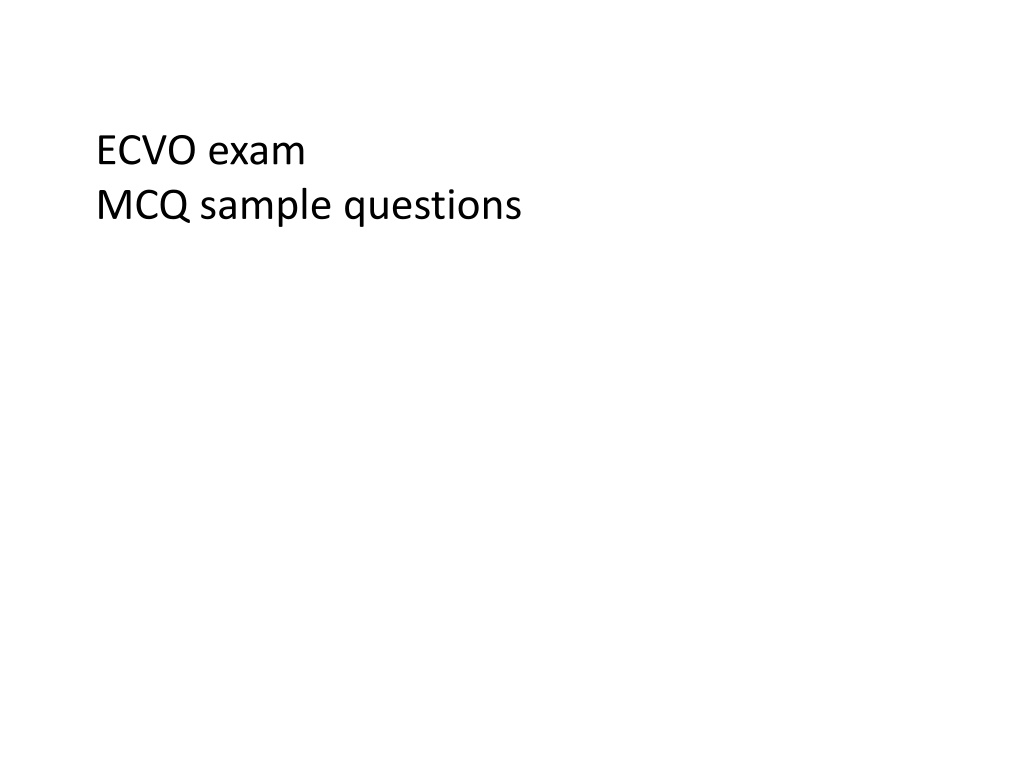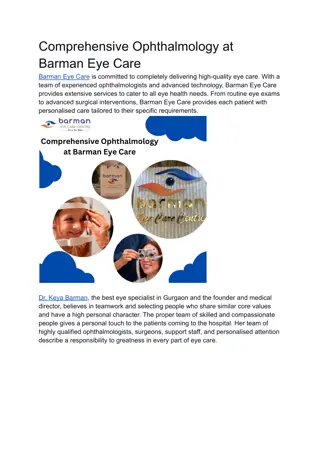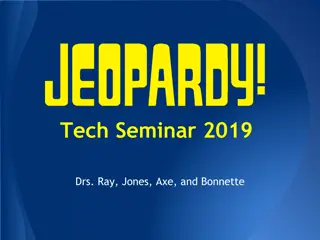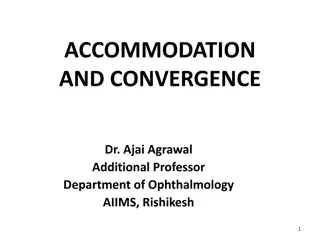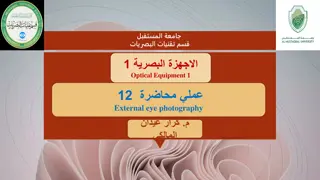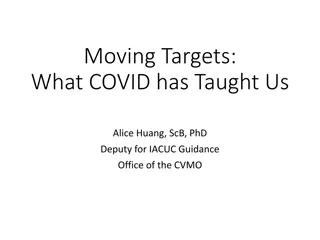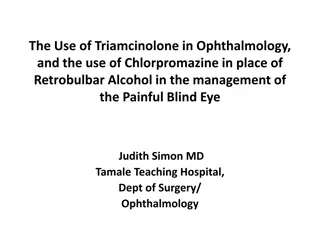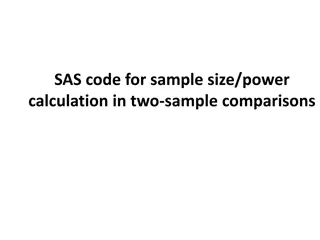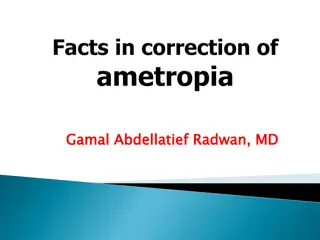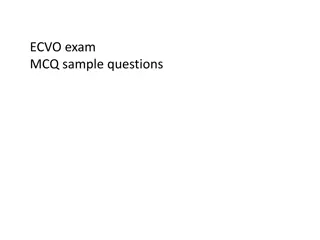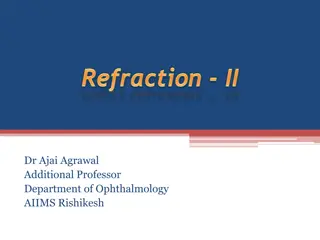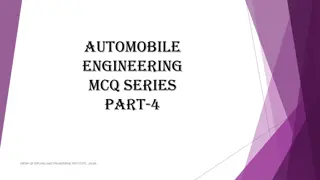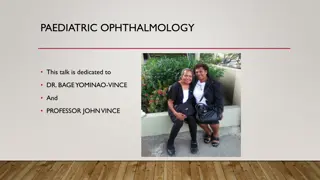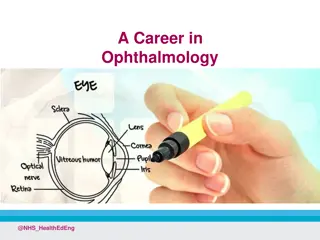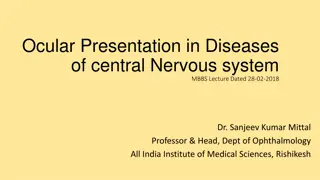Ophthalmology MCQ Sample Questions for Veterinary Ophthalmologists
Explore a set of multiple-choice questions related to veterinary ophthalmology, covering topics such as ocular anatomy, embryonic development, special features in different animals' eyes, diagnostic techniques, and lesion location in cases of anisocoria. Test your knowledge with these informative questions and images.
Download Presentation

Please find below an Image/Link to download the presentation.
The content on the website is provided AS IS for your information and personal use only. It may not be sold, licensed, or shared on other websites without obtaining consent from the author. Download presentation by click this link. If you encounter any issues during the download, it is possible that the publisher has removed the file from their server.
E N D
Presentation Transcript
ECVO exam MCQ sample questions
Which one of the following bones contributes to the orbit in the horse but not in cattle? a) Zygomatic. b) Maxillary. c) Sphenoid. d) Temporal.
Failure of normal development of what ocular embryonic structure on day 30 of gestation has been associated with the development of posterior segment colobomas in homozygous merle Australian Shepherd dogs? a) Inner neuroblastic layer. b) Retinal pigment epithelium. c) Periocular mesenchyme. d) Outer neuroblastic layer.
A special feature of the frog eye is: a) Absence of a retractor bulbi muscle. b) Presence of a conus papillaris. c) Absence of an orbital septum. d) Presence of scleral ossicles.
Streak retinoscopy (skiascopy) is performed in a dog at a working distance of 66 cm. Neutralization is seen in the horizontal meridian at +2 Diopters and in the vertical meridian at +0.5 Diopters. This eye should be classified as: a) Astigmatic. b) Myopic. c) Hyperopic. d) Anisetropic.
Corneal lipidosis is readily diagnosed histologically with: a) Oil-red-O stains of frozen sections. b) Sudan black stains of paraffin sections. c) Mucicarmine stains of paraffin sections. d) Sections prepared from Zencker's fixed tissues.
You examine a dog with anisocoria. The left pupil is normal but the right is moderately dilated in ambient light. Light into either eye constricts the left but not the right pupil. In darkness the left pupil becomes maximally dilated and the right remains moderately dilated. The most likely location for the lesion is: a) Right optic nerve. b) Right optic tract. c) Right oculomotor nucleus. d) Right ciliary ganglion.
Which one of the following statements is true concerning suture materials for ophthalmic surgery? a) Prolene (polypropylene) is not hydrolyzed like nylon (polyamide) is, but is more slippery and more prone to knot instability. b) Nylon (polyamide) loses an estimated 30% of its tensile strength due to hydrolyzation in the first year after application. c) The amount of tissue reaction is greater for surgical gut than for polyglactic acid, but the two have similar duration of tensile strength over time. d) Both nylon and polypropylene (prolene) are prone to break during continuous suturing, due to their low elasticity.
Which one of the following statements is true concerning equine recurrent uveitis (ERU) and Leptospira interrogans infection? a) Among horses with uveitis, there is no difference in the risk of loss of vision between Leptospira seropositive horses and Leptospira seronegative horses. b) When related to Leptospira infection, ERU is a late sequel to the infection, with ocular signs developing 12-24 months after inoculation. c) In seropositive horses, anti-Leptospira antibodies may be demonstrated in serum and tears, but not in aqueous. d) In inflammatory nodules in the iris and ciliary body of affected horses, B lymphocytes predominate.
Which one of the following statements is correct concerning the optic nerve and its ganglion cells in dogs ? a) Alpha retinal ganglion cells have large cell bodies, large dendritic fields and large-diameter axons. b) The optic nerve is divided into these regions: intraocular, intraorbital and intracranial. c) Alpha retinal ganglion cells are more densely distributed in the central retina and beta cells in the peripheral retina. d) There are no centrifugal axons from the central nervous system to the retina.
Disease of the petrous temporal bone proper (petrositis) or within (e.g. otitis media or interna) may involve more than one nerve that courses through it. Which nerves may be directly involved? a) Motoneurons of facial (VII) nerve, postganglionic sympathetic fibers, preganglionic parasympathetic fibers, glossopharyngeal (IX) nerve, chorda tympani (from VII). b) Only motoneurons of facial (VII) nerve, postganglionic sympathetic fibers, preganglionic parasympathetic fibers may be involved, but never glossopharyngeal (IX) nerve or chorda tympani (from VII). c) Motoneurons of facial (VII) nerve, preganglionic sympathetic fibers, postganglionic parasympathetic fibers, glossopharyngeal (IX) nerve, chorda tympani (from VII). d) Only motoneurons of facial (VII) nerve, preganglionic parasympathetic fibers, glossopharyngeal (IX) nerve or chorda tympani (from VII).
Which one of the following statements is true with regard to viscoelastic materials in veterinary ophthalmology? a) Cohesive viscoelastics are believed to be more likely to result in postsurgical hypertension than dispersive viscoelastics. b) Cohesive viscoelastics have a low viscosity/molecular weight, while dispersive viscoelastics have a high viscosity/molecular weight. c) Cohesive viscoelastics offer better protection for the corneal endothelium during intraocular surgery than dispersive viscoelastics. d) The term pseudoplasticity is used to define the phenomenon that viscosity (of a viscoelastic) increases with higher shear rate (=faster movement, e.g., through a cannula).
When performing specular microscopy, the angle of the incident light, relative to the observation system is: a) 0 degrees (i.e. the path of the incident light is the same as the observations system). b) 20 degrees. c) 45 degrees. d) 90 degrees.
What is a common cause of panuveitis in poultry? a) Enterococcosis. b) Mycoplasmosis. c) Chlamydiosis. d) Salmonellosis.
Accola et al evaluated three retrobulbar injection techniques in dogs (JAVMA 2006). Which one of the following statements is correct according to this paper? a) Intraconal injections of anaesthetic agents resulted in the most rapid and consistent effects but required a higher volume. b) The combined superior-inferior peribulbar approaches provided the best akinesia and additional ocular analgesia. c) The inferior-temporal palpebral technique seemed to be the best alternative to systemic neuromuscular blocking. d) The perimandibular technique required a low volume of anaesthetic and was the safer way of injection.
In a review by Kubai et al. (Refractive states of eyes and association between ametropia and breed in dogs , AJVR 2008), which of the following statements was correct ? a) Mean refractive state of all eyes examined was - 0.5 D (emmetropia). b) Mean refractive state of all eyes examined was + 0.05 D (emmetropia). c) Astigmatism was detected in 10% of adult dogs. d) Astigmatism was detected in 1% of adult dogs.
According to May et al (Choroidal microcirculation in Abyssinian cats with hereditary rod-cone degeneration , Exp Eye Res 2008), which of the following statements is correct? a) RPE and choriocapillaris show atrophy evenly distributed across the tapetal and non-tapetal fundus. b) Unlike in other species, RPE and choriocapillaris remain unaffected throughout the fundus. c) RPE and choriocapillaris remain unaffected in areas covered by tapetum lucidum. d) Areas covered by tapetum lucidum are specifically affected by loss of RPE and choriocapillaris
Hofmeister et al (VAA 2008) investigated the effects of propofol and thiopental on peri- induction IOP in normal dogs. Which of the following statements is correct? a) Both propofol and thiopentone cause insignificant increases in IOP. b. Propofol caused a significant increase in IOP. c) Thiopental caused a significant increase in IOP. d) Propofol caused an insignificant increase in IOP.
Schlueter et al used CT to study head conformation and the nasolacrimal drainage system (NDS) in mesencephalic and brachycephalic cats (JFMS 2009). From their study, which of the following statements is NOT true? In severely brachycephalic cats: a) The root of the upper canine tooth adjoined the nasolacrimal sac. b) The nasal ostium was higher than the level of the lower lacrimal punctum. c) The NDS reduced to around 5mm in length. d) The upper lacrimal canaliculus was not detectable.
Hendrix et al. (Veterinary Ophthalmology 2008) studied the pharmacokinetics in tears of topically applied ciprofloxacin in dogs. Which of the following statements is true? a) A concentration above the MIC90 remains for a maximum of 4 hours. b) A concentration above the MIC90 remains for at least 6 hours. c) The concentration remained longer abover the MIC90 in brachycephalic dogs. d) The mean tear production in brachycephalic dogs was lower than in mesocephalic dogs.
According to Naranjo et al (Veterinary Ophthalmology 2008) canine ocular gliomas: a) Never extend to the anterior uvea. b) Are more common in Golden Retrievers. c) Can lead to exophthalmia. d) Can be removed with tumour free surgical margins via enucleation.
Correct answers: 1d 2b 3c 4a 5a 6d 7a 8b 9a 10a 11a 12c 13d 14c 15d 16c 17b 18c 19b 20c
